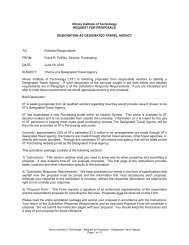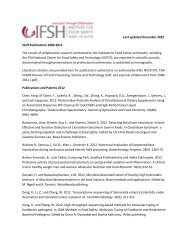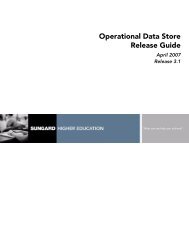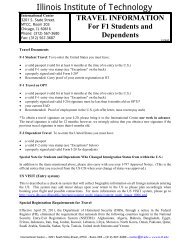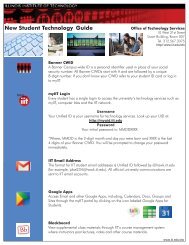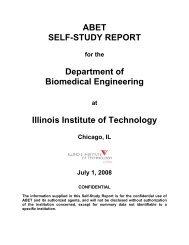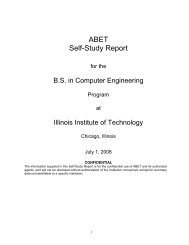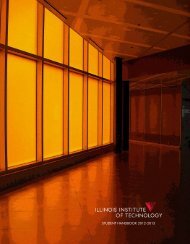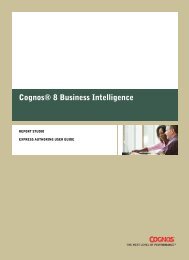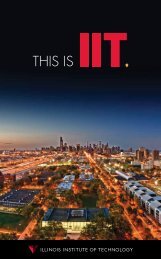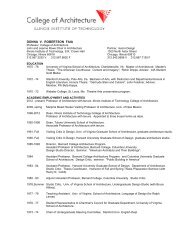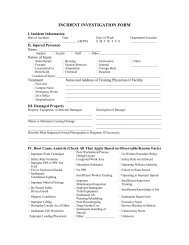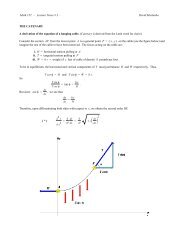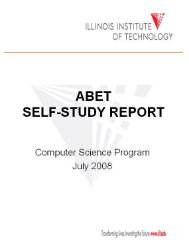Copyright & Disclaimer Information - Illinois Institute of Technology
Copyright & Disclaimer Information - Illinois Institute of Technology
Copyright & Disclaimer Information - Illinois Institute of Technology
You also want an ePaper? Increase the reach of your titles
YUMPU automatically turns print PDFs into web optimized ePapers that Google loves.
ECE 565<br />
Computer Vision and Image Processing<br />
ECE 566<br />
Statistical Pattern Recognition<br />
ECE 567<br />
Statistical Signal Processing<br />
ECE 568<br />
Digital Speech Processing<br />
ECE 569<br />
Digital Signal Processing II<br />
ECE 570<br />
Fiber-Optic Communication Systems<br />
ECE 571<br />
Seminar on Nanodevices and <strong>Technology</strong><br />
ECE 575<br />
Electron Devices<br />
ECE 576<br />
Antenna Theory<br />
ECE 577<br />
Advanced Antenna Theory<br />
ECE 578<br />
Microwave Theory<br />
ECE 579<br />
Numerical Methods in Electromagnetics and Solid-<br />
State Electronics<br />
ECE 583<br />
High Speed Computer Arithmetic<br />
ECE 584<br />
Advanced Switching Theory<br />
ECE 585<br />
Advanced Computer Architecture<br />
ECE 586<br />
Fault Detection in Digital Circuits<br />
ECE 587<br />
Hardware/S<strong>of</strong>tware Codesign<br />
ECE 588<br />
CAD Techniques for VLSI Design<br />
<strong>Copyright</strong> & <strong>Disclaimer</strong> <strong>Information</strong>: <strong>Copyright</strong> © 1994, 1995, 1996, 1997, 1998, 1999, 2000, 2001, 2002, 2003, 2004, 2005, 2006, 2007. CollegeSource®, Inc. and Career Guidance Foundation. CollegeSource® digital catalogs are derivative works owned and copyrighted by CollegeSource®, Inc. and Career Guidance Foundation. Catalog content is owned and copyrighted by the appropriate school. While CollegeSource®, Inc. and Career Guidance Foundation provides information as a service to the public, copyright is retained on all digital catalogs.<br />
<strong>Copyright</strong> & <strong>Disclaimer</strong> <strong>Information</strong>: <strong>Copyright</strong> © 1994, 1995, 1996, 1997, 1998, 1999, 2000, 2001, 2002, 2003, 2004, 2005, 2006, 2007. CollegeSource®, Inc. and Career Guidance Foundation. CollegeSource® digital catalogs are derivative works owned and copyrighted by CollegeSource®, Inc. and Career Guidance Foundation. Catalog content is owned and copyrighted by the appropriate school. While CollegeSource®, Inc. and Career Guidance Foundation provides information as a service to the public, copyright is retained on all digital catalogs.<br />
Economics<br />
ECON 151<br />
The Economics <strong>of</strong> the Firm<br />
The course looks at the consequences<br />
<strong>of</strong> scarcity on business behavior—the<br />
use <strong>of</strong> cost-benefit analysis, opportunity<br />
cost, and comparative advantage.<br />
It examines the influence <strong>of</strong><br />
supply and demand on markets, and<br />
the influence <strong>of</strong> cost conditions and<br />
market structure on the behavior <strong>of</strong><br />
the firm. The concept <strong>of</strong> economic<br />
efficiency is then used to examine<br />
government regulation <strong>of</strong> business.<br />
(3-0-3) (S) (C)<br />
ECON 152<br />
National and Global Economics<br />
The course looks at national and<br />
international statistics—real output,<br />
inflation, unemployment, and interest<br />
rates. It examines fiscal and monetary<br />
policy and how they influence the<br />
important measures <strong>of</strong> an economy’s<br />
performance. Then the analysis is<br />
extended to the interaction between<br />
national economies and how this<br />
influences trade and capital flows<br />
between countries and determines<br />
exchange rates. (3-0-3) (S) (C) (E)<br />
ECON 211<br />
Principles <strong>of</strong> Economics<br />
The determination <strong>of</strong> output, employment<br />
and the rate <strong>of</strong> inflation. Topics<br />
include a broad-based discussion <strong>of</strong> the<br />
controversies in macro-economics, the<br />
appropriate use <strong>of</strong> fiscal and monetary<br />
policy, the effects <strong>of</strong> a budget deficit,<br />
determination <strong>of</strong> the rate <strong>of</strong> exchange,<br />
and the trade deficit. Offered in fall<br />
and spring. (3-0-3) (S)<br />
ECON 423<br />
Economic Analysis <strong>of</strong> Capital Investments<br />
The evaluation <strong>of</strong> proposed capital<br />
investments in the public and private<br />
sectors. Equivalent worth, rate <strong>of</strong><br />
return, and benefit/cost methods.<br />
Treatment <strong>of</strong> the time value <strong>of</strong><br />
money, taxes, inflation, risk, inter<br />
related investments and capitalbudgeting.<br />
Credit for this course not<br />
applicable to a B.S.B.A. or a<br />
B.S.B.A.A.S. degree. Offered in fall<br />
and spring. (3-0-3) (S)<br />
IIT Undergraduate Bulletin 2006–2008<br />
Engineering Graphics<br />
Course Descriptions<br />
EG 100<br />
Basic Technical Drawing<br />
Designed for students who are not<br />
prepared to take EG 105 because<br />
they have had little or no high school<br />
technical drawing or who need a<br />
slower approach to the subject.<br />
Special emphasis is placed upon the<br />
use <strong>of</strong> instruments, lettering, line<br />
technique, and introductory multiview<br />
projection. (0-4-1)<br />
EG 105<br />
Engineering Graphics and Design<br />
Basic traditional and computerbased<br />
techniques and applications,<br />
multiview sketching, orthographic<br />
projection, isometric and oblique<br />
pictorials, sectioning, auxiliary views,<br />
principles <strong>of</strong> descriptive geometry,<br />
dimensioning, detail drawings, introduction<br />
to design and computeraided<br />
drafting and design (CAD).<br />
Prerequisites: Trigonometry. (1-2-2)<br />
EG 204<br />
Blueprint Reading<br />
for Machine Industries<br />
Industrial prints, views <strong>of</strong> objects,<br />
analysis <strong>of</strong> edges and surfaces,<br />
sectional views, auxiliary views,<br />
screw threads and fasteners, dimensioning,<br />
shop processes, first-angle<br />
drawing, R.H. and L.H. drawings,<br />
and welding representation. (1-3-2)<br />
EG 224<br />
Blueprint Reading<br />
for Building Trades<br />
Analysis <strong>of</strong> building construction<br />
drawings and details, dimensioning,<br />
shop processes, use <strong>of</strong> symbols and<br />
conventions, material take<strong>of</strong>f, and<br />
elementary estimating. (1-3-2)<br />
EG 225<br />
Engineering Graphics for Non-Engineers<br />
Designed for students in business, liberal<br />
arts and non-technical programs.<br />
Basic drafting techniques and applications,<br />
lettering, geometric constructions,<br />
charts and graphs, technical<br />
sketching, multiview projection, pictorial<br />
drawings, dimensioning, blueprint<br />
reading and working drawings.<br />
Introduction to computer graphics.<br />
Credit for this course is not applicable<br />
to an engineering degree. (2-1-3)<br />
181



